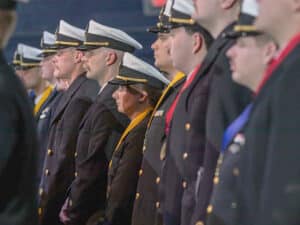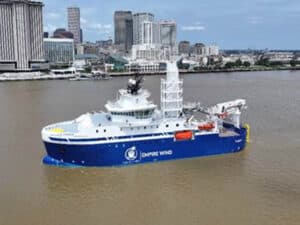
LNG fueled ferry now world’s fastest ship
Written by Nick Blenkey JUNE 19, 2013 — Australian shipbuilder Incat Tasmania says that its hull 069 is now the world’s fastest ship as well as the world’s first high speed dual-fuel vehicle and passenger ferry.
JUNE 19, 2013 — Australian shipbuilder Incat Tasmania says that its hull 069 is now the world’s fastest ship as well as the world’s first high speed dual-fuel vehicle and passenger ferry.
The 99 m vessel attained a lightship speed of 58.1 knots (107.6 km/hr) in speed trials last week.
“This is certainly the fastest ship in the world,” says Incat, noting that “of course there’s a few speed boats that could surpass 58 knots but nothing that could carry 1,000 passengers and 150 cars, and with an enormous duty free shop on board.”
The ferry is being built for long time Incat customer Buquebus of Argentina.
When she started sea trials (see earlier story) she was referred to by the name Lopez Mena, but now Buquebus has decided she will carry the name Francisco, in honour of the Argentinian born Pope Francis. Godmother to the ship will be the President of Argentina, Christina Fernandez de Kirchner, who will christen Francisco following the ship’s arrival in Argentina. She will operate on the River Plate, between Buenos Aires and Montevideo, Uruguay.
Last week at 1,516 tonne displacement trial she achieved 51.8 knots at 100 percent MCR operating with one of her two gas turbines operating on LNG and one on marine distillate, exceeding the results achieved on June 1, when Francisco was sea trialed with full ballast comfortably exceeding 50 knots at full power and maintaining a steady 49 knots at 90 per cent power while operating on marine distillate.
On Saturday, June 15, with the water ballast removed, and with both port and starboard gas turbines operating on LNG; Francisco achieved 58.1 knots at 100 percent MCR.
The vessel’s high speed can be attributed to the combination of Incat wave piercing catamaran design, the use of lightweight, strong marine grade aluminum, and the power produced by the two 22MW GE LM2500 gas turbines driving Wartsila LJX 1720 SR waterjets.
The extensive and luxurious interior made significant increases to the weight of the interior fitout, however the Incat team worked diligently to maximize weight savings during construction wherever possible.
Incat is still not claiming 58.1 as the end point of lightship trials as there was a full load of LNG on board (two 40 cu. m tanks) in addition to about 35 tonnes of marine distillate.
“When we have less fuel on board, and delivery spares removed, we will see that speed go higher still in the shallow waters of the River Plate (Rio Plata),” says Incat Chairman Robert Clifford. “We are delighted with the efficiency of the design and sure that our customer, Buquebus, will be pleased with the results, enabling the ferry to compete with airline traffic on the River Plate route.”
Francisco has capacity for 1,000 persons and 150 cars. A luxurious fit out has been incorporated, including a 1,100 square metre duty-free shop.
Buquebus has demonstrated its preference for Incat technology over a twenty year period and Francisco (hull 069) is the eighth Incat vessel to be operated by Buquebus and its associated companies. It will be the largest catamaran it has operated, the world’s first dual fuel high speed ferry to operate on LNG as its primary fuel, and the fastest, environmentally cleanest, most efficient, high speed ferry in the world.
Incat’s High Speed Record
The fastest previous vessel built by Incat was Juan Patricio, delivered also to Buquebus, with a top speed at 53.8 knots. Juan Patricio was delivered in 1996 and remains in commercial service. Francisco is the fourth Incat built vessel with service speed over 50 knots.
The past three consecutive winners of the Hales Trophy, the Transatlantic speed record for commercial passenger ships, were all built by Incat. The average speed over the three day (unrefueled) voyage of Incat hull 049 was 41.284 knots.
Incidentally, traditionalists insist that the Hales Trophy is not the same thing as the Blue Riband. They assert that the S.S. United States remains as the holder of the Blue Riband because all subsequent record breakers were not in Atlantic passenger service and their voyages were eastbound.
Incat has built 25 High Speed Craft over 5,000 gross tonnes with a top speed in excess of 45 knots.





Leave a Reply
You must be logged in to post a comment.